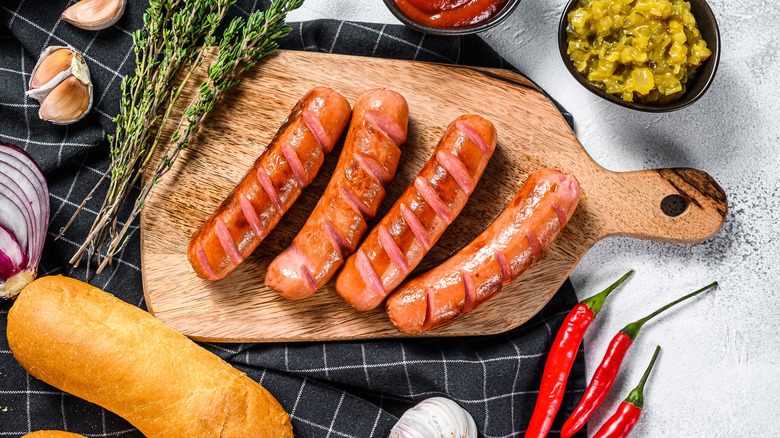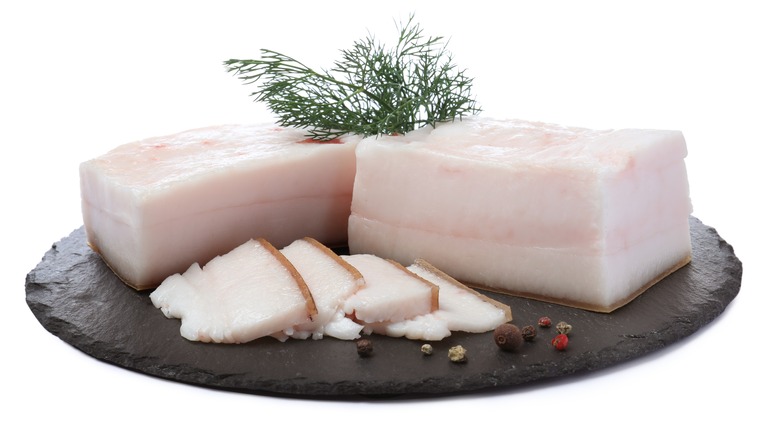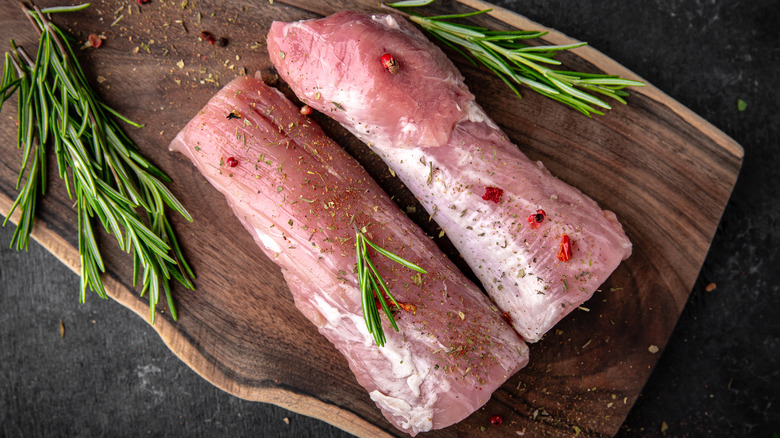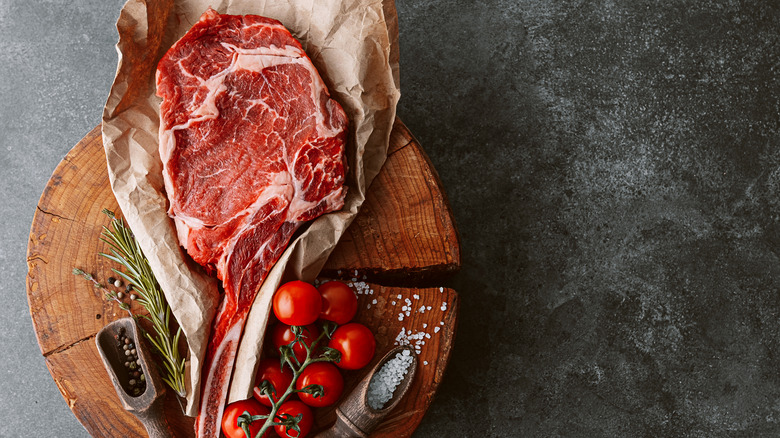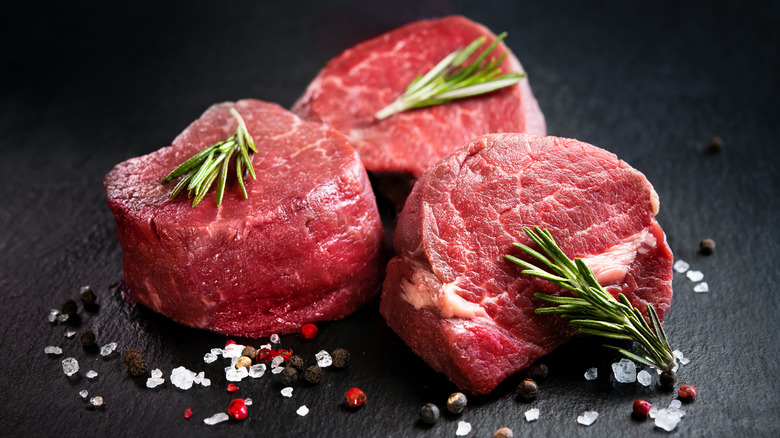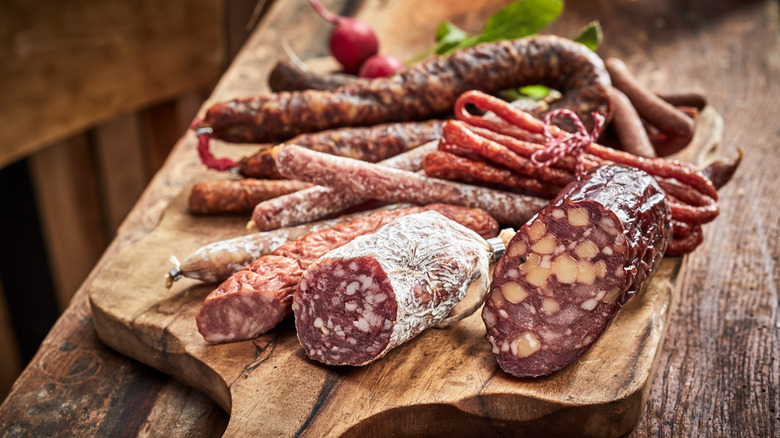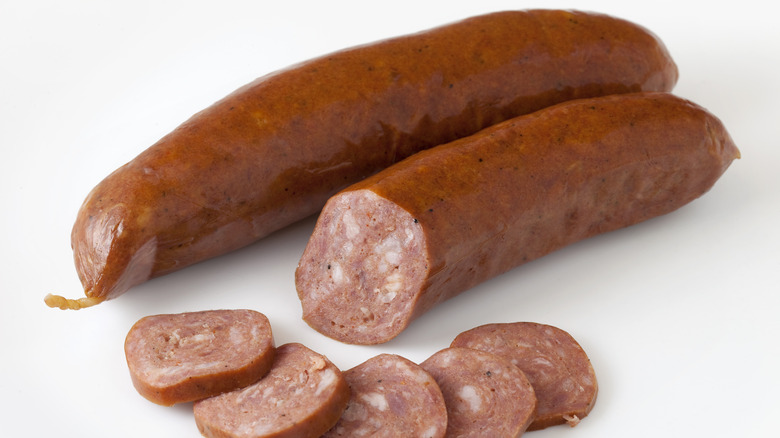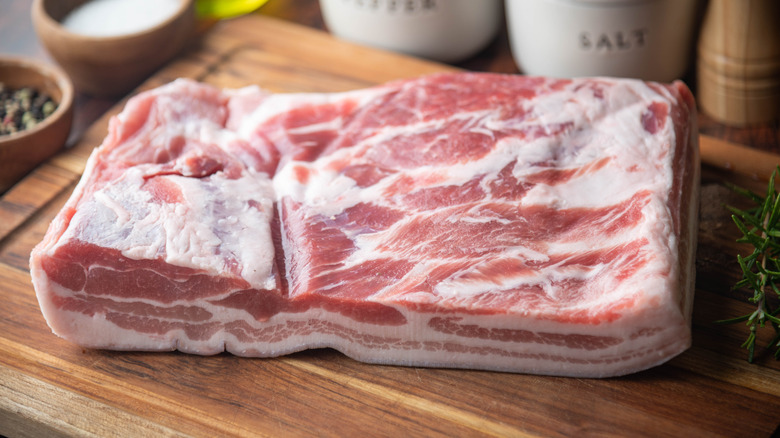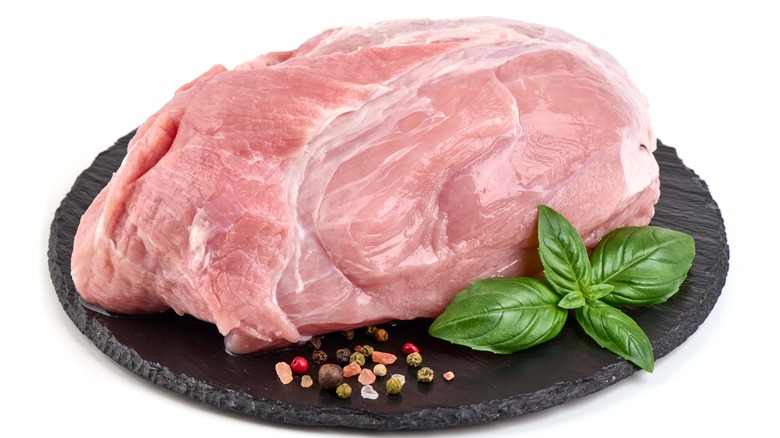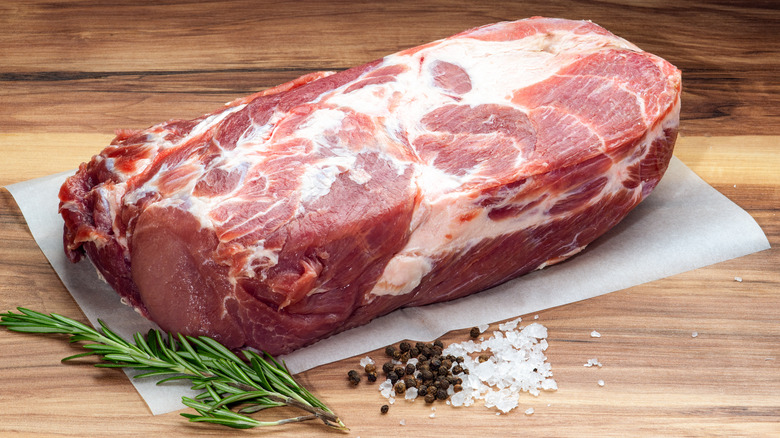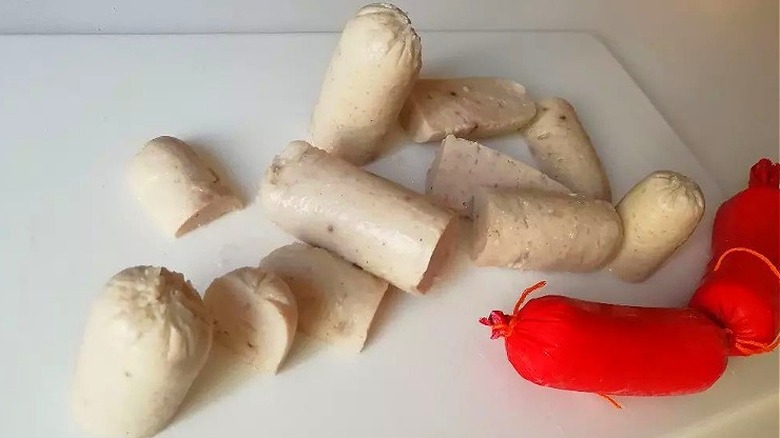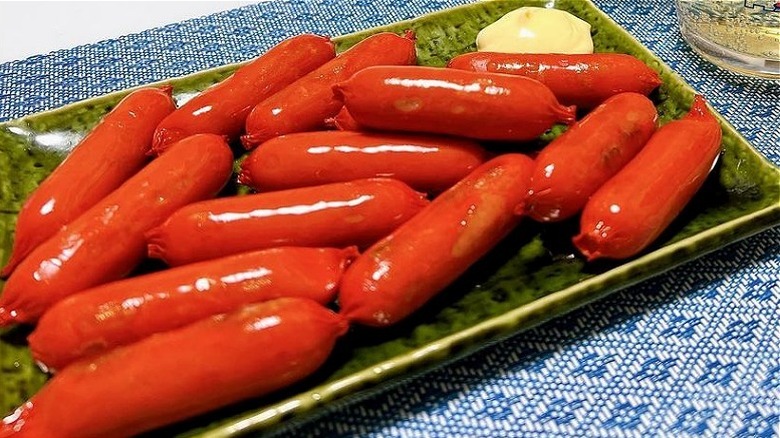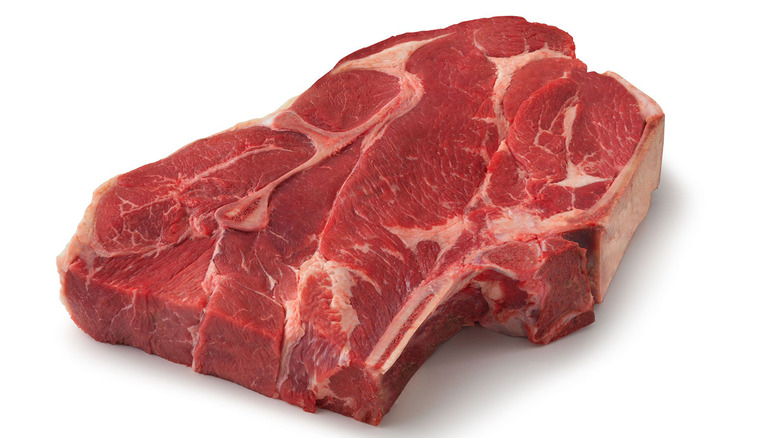Ranking Cuts Of Meat For Making Sausage, From Worst To Best
It's often part of breakfast, cooked on a grill, found in a bun, or served with a side of mashed potatoes, but we've been making and enjoying sausage in countless ways throughout history. It's difficult to discern which culture first came up with the idea of encasing ground meat inside the sleeve of the intestine as a form of food preservation because sausage has long been part of our global palette, with every country adding to the still-growing tapestry of sausage-making (via Atlas Obscura). If you're looking to make your own sausage, then there are a number of rules that need to be followed, one of the most important being the selection of the proper cut of meat.
Depending on the type of sausage made, one of the most important details is to have the right balance between fat and meat. Fat not only lends flavor and mixes well with added spices but also keeps the sausage from falling apart or becoming "crumbly." Keep this in mind with different cuts of meat, as you may add fat to some degree.
Fatback
While fat is often a necessity for sausage-making, one cannot exist on fat alone. If a lack of fat causes the sausage to crumble apart easily, then an overabundance will leave sausages overly greasy, not just with texture but also in taste. Considering that fatback comes from pork, it would be almost the equivalent of drinking bacon grease. "Too much of a good thing" is an apt saying when it comes to adding fatback to sausage.
But there's a reason why it's a popular addition to the sausage-making process. According to Cooking Chops, fatback's popularity comes from its neutral flavor. Meaning that on its own, fatback has little to no flavor, but it quickly becomes a sponge when mixed with assorted meats, herbs, and spices. While beef fat can be used as a less expensive alternative, beef fat comes with its own very strong scents and flavors, which can disrupt the taste of your sausage. Remember that while fatback is a popular fat addition, remember to include meat in the mix.
Pork Tenderloin
Pork is one of the most popular meats for making sausage as you can create different flavors such as sweet ones for breakfast sausage or ones more on the savory herb side. But it depends on what cut of pork you're using that determines how good your sausage will be. For instance, tenderloin is a prime cut that's great for making a roast. However, due to its general lack of fat, it's not a great choice for making pork sausage (via Ontario Pork).
Also, considering that the tenderloin is located along the pig's spine, it's a part of pork that doesn't get a lot of regular movement. That means the meat runs the risk of becoming chewy and is turned into a sausage. When it comes to sausage-making, you'll learn that the most valued cuts of meat might do great on the grill or in an oven but are abysmal when it comes to sausages.
Eye of Round Steak
There's a good reason why most beef sausages contain a certain amount of pork, if not equal amounts of pork and beet, such as in German sausage-making (via Meats and Sausages). The reason once again has to do with fat content, and while beef does have an amount of fat often marbled into the meat, it's not enough to make proper sausage. A sausage made purely from a lean cut of meat, such as an eye of round steak, will create a sausage that is hard in texture and very tough to eat. This is simply because the fat in sausage allows the meat to become lubricated by the rendered fat while it's cooking inside the casing. This is what makes sausage tender, juicy, and delicious.
The USDA considers the eye of round steak to be "extra lean" regarding fat content (via Mayo Clinic). That means that the steak contains less than 5% of the total fat. Now, if you're looking to watch your cholesterol, this news is outstanding. But if you're looking for good sausage meat, you might want to look elsewhere or break out the fatback. Sausage is not for those looking to lower their cholesterol. Even trying to make a "low fat" sausage will most likely mean you'll be spending a lot of time chewing something really dried out.
Prime cuts of beef
There might be nothing sadder than trying to enjoy a dish like beef stroganoff, only to find out it was cooked using cuts of filet mignon. Sausage, much like a dish of beef stroganoff, works far more effectively when using what would be considered scraps. According to Your Meat Guide, a good ratio between meat and fat would sit around 80/20. While cuts like ribeye, T-bone, and porterhouse steaks are greatly enjoyed for being well marbled with pockets of fat nesting inside the meat, it's not nearly enough for sausage.
Always remember that when it comes to beef sausage, have enough fat to make sure they don't toughen when they're cooked. Since the sausage is usually made with what others would call the throwaway parts of beef, it's best to save the prime cuts from being pan-fried or grilled and given some distance from the meat grinder.
Venison
For those who enjoy hunting or at least eating something a bit closer to nature, game sausage is a popular item for campers and wilderness enthusiasts. Specifically, sausage made from venison goes great with the right ingredients and is pan-fried over the open flame of an evening campfire. According to Honest Food, venison often carries the flavor of what it ate in the wilderness, such as acorns, sage, and other herbs. It's not as rich or juicy as beef or pork, but it tastes cleaner and is not as greasy. Wild venison can be "gamey," meaning that its time in the wild has left with much stronger scents and flavors. But with the right mix of herbs or a marinade, the sensory overload can be turned down.
However, because venison is considered ultra-lean, adding fat is imperative to make a cohesive sausage. One important tip is to ensure that neither the added fat nor the venison has been frozen. This is because once everything is ground for sausage, even previously frozen venison will have difficulty bonding with the fat when the sausage is being cooked. Also, like beef or pork, stick with the "scrap" parts of venison for good sausage.
Game meat
One of the great things about sausage is that you can make it out of practically anything with proper preparedness and ingredients. In regards to game sausage, venison need not be the only wild game out there for good sausage meat. Elk, bison, ostrich, rabbit, duck, and a wide variety of other game meats can be made into sausage, each bringing something new and unique to the table. According to Price of Meat, bison has a cleaner and even sweeter flavor than beef. Chef's Pencil states that rabbit has a similar taste and texture to chicken, placing it among the white meat category.
Always keep in mind that, like any other kind of sausage, to make sure you're using the right cuts. Much like beef or pork, using leaner cuts will get you nowhere. The best cuts on almost any animal to use on sausage are the tough cuts found on the neck and the shoulders, and they usually contain plenty of fat which will mix well when ground down (via Petersen's Hunting). Also, most game meat is one of the leaner varieties, so always add extra fat to the mix. Fatback plays a significant role when it comes to making game sausage due to its aforementioned neutral taste.
Pork Belly
Much like fatback, pork belly is far more fat than meat. Meaning that you'd run into the same issues if you were to make sausage with this cut as your star attraction. However, like fatback, pork belly can make for a great addition to accentuate the flavor of pork sausage while keeping it juicy and held together inside the casing after cooking. What separates pork belly from fatback, however, is that pork belly tends to have more flavor, which isn't a surprise as pork belly is the part of the pig used to make bacon.
The Manual states that pork belly is an ideal fat for those wanting to make breakfast sausage. Considering that most breakfast sausage is mainly made from pork, using fat usually reserved for bacon will help the sausage achieve that right balance of smokey and sweet flavor. Even if pork isn't your choice for breakfast sausage, pork belly is still an excellent addition to fats.
Pork Butt
Here we are at a truly fine cut of meat for good sausage-making. Though considered tougher, cheaper, and more meant for the stewpot, pork butt is an indeed choice cut when one wants to make sausage. According to the Los Angeles Times, pork has been a long celebrated meat for sausage-makers as relatively cheap meat that tenderizes easily when ground and is so well marbled with fat that few dishes are rendered dried out. Pork butt, also known as "Boston Butt," is not found on the rump of pork but rather on a cut around the shoulder. This cut has a better ratio of fat and meat, meaning that when ground, it will mix well and create a sausage that keeps together and stays juicy after cooking.
With all the talk of adding fat to sausage, it's easy to ask why not purchase store-bought sausages since they'd also be loaded with fat. However, the same article points out that store-bought sausage often has a fat ratio of over 50%, compared to the range of 15-30% homemade sausage.
Pork Shoulder
If the pork butt around the shoulder makes for good sausage, so would the pork shoulder itself. In an article by Eat Cured Meat, pork shoulder falls under the category of hard pork fat. That means that pork shoulder's a more firm, tough consistency, which means that it can be ground into a more desired consistency for sausages. Hard fat also carries a high melting point, meaning that as the meat cooks inside the sausage, it will not lose all of the fat in the process. However, unlike the pork butt, the shoulder is tougher and doesn't contain as much fat, according to Smoked BBQ Source. That doesn't mean that it's a bad cut for sausage; quite the opposite. The tough meat makes it better to mince and can make for a better-formed sausage.
Remember that even though the shoulder contains fat, you may add more to make up the correct ratio for proper sausage.
Fresh chicken
As it has been well established, one can make sausage out of white meat and have it come out very well indeed. While pork remains one of the kings of sausage meat, it turns out that chicken sausage can be a more health-conscious sausage alternative. When compared to pork sausage, chicken sausage contains less total fat and sodium and provides slightly more protein. Chicken sausage also tastes cleaner and also less greasy than either pork or beef sausage.
However, store-bought chicken sausage can have numerous additives that make it a better idea to make your own. According to AllRecipes, numerous chicken sausage products contain high levels of nitrates: a combination of nitrogen and oxygen typically used for preserving cured meats. However, nitrates also can increase the risk of certain cancers. Likewise, store-bought chicken sausage is susceptible to similar additives found in all store-bought sausages like high sugar, food colorings, and preservatives. So if chicken sausage is of interest, you might want to pick up a meat grinder.
Fish
If poultry like chicken or duck can be made into sausage, then the next obvious step would be the consideration of fish sausage. Much like sausage, it uses finely minced fish scraps and is cooked within a casing containing fats, spices, herbs, and other vegetables. Far from being anything new on the culinary scene, fish sausage has long been enjoyed from across the East, such as in Japan and Korea, as well as areas along the Mediterranean in Italy and Central Europe. Each country, according to Masterclass, has its fish sausage recipe either in soup or as a hot dog or burger.
Surprisingly, making fish sausage has similar rules to its preparation compared to classic meat sausage. For instance, fish sausage can be minced like pork, poultry, or beef, where the sausage can have various textures from coarse to a more fine paste. However, ingredients like corn or potato starch are added to the fish sausage to maintain its form and consistency. If you're looking for a new form of sausage to enjoy, then using fish comes with its own wide range of dishes.
Beef Chuck
Found on the shoulders of beef, the chuck makes for the perfect cut for good sausage making. Daydream Kitchen states that the fat content of beef chuck is around 15-20%, making it a fine candidate to be turned into sausage without additional fat. Not only is it high in fat for good sausage prep, but considering the price of beef, it is relatively one of the less expensive cuts. If you're hankering to make beef sausage, you could do no better than grinding down a few hunks of beef chuck. You'll get everything that makes sausage so celebrated from this one slab. Minced meat stewed in rendered fat while nested inside an intestine casing that'll snap with a first bite, containing juicy meat packed with all sorts of flavors you've added.
It cannot be overstated enough that sausage was made to preserve even the most obscure bits of meat off an animal. But like with any cooking, just because the meat is of lower quality doesn't mean the freshness needs to be. Always remember that even throw-away bits need to be fresh, and your sausage will come out table-ready every time.
